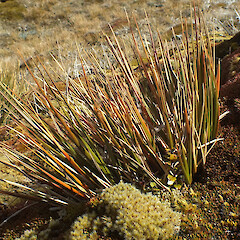Chionochloa crassiuscula subsp. crassiuscula
Common name
pungent snow tussock
Synonyms
Danthonia pungens (Cheeseman) Zotov
Family
Poaceae
Flora category
Vascular – Native
Endemic taxon
Yes
Endemic genus
No
Endemic family
No
Structural class
Grasses
NVS code
The National Vegetation Survey (NVS) Databank is a physical archive and electronic databank containing records of over 94,000 vegetation survey plots - including data from over 19,000 permanent plots. NVS maintains a standard set of species code abbreviations that correspond to standard scientific plant names from the Ngä Tipu o Aotearoa - New Zealand Plants database.
CHISCR
Chromosome number
2n = 42
Current conservation status
The conservation status of all known New Zealand vascular plant taxa at the rank of species and below were reassessed in 2017 using the New Zealand Threat Classification System (NZTCS) – more information about this can be found on the NZTCS website. This report includes a statistical summary and brief notes on changes since 2012 and replaces all previous NZTCS lists for vascular plants.
Please note, threat classifications are often suggested by authors when publications fall between NZTCS assessment periods – an interim threat classification status has not been assessed by the NZTCS panel.
- Conservation status of New Zealand indigenous vascular plants, 2017 . 2018. Peter J. de Lange, Jeremy R. Rolfe, John W. Barkla, Shannel P. Courtney, Paul D. Champion, Leon R. Perrie, Sarah M. Beadel, Kerry A. Ford, Ilse Breitwieser, Ines Schönberger, Rowan Hindmarsh-Walls, Peter B. Heenan and Kate Ladley. Department of Conservation. Source: NZTCS and licensed by DOC for reuse under the Creative Commons Attribution 4.0 International licence.
2017 | At Risk – Naturally Uncommon | Qualifiers: RR, St
Previous conservation statuses
2012 | At Risk – Naturally Uncommon | Qualifiers: RR
2009 | At Risk – Naturally Uncommon
2004 | Range Restricted
Habitat
Upper montane, subalpine or alpine. Usually in herbfields where it may be the dominant species. Also boggy meadows, and scrub.
Wetland plant indicator status rating
Information derived from the revised national wetland plant list prepared to assist councils in delineating and monitoring wetlands (Clarkson et al., 2021 Manaaki Whenua – Landcare Research Contract Report LC3975 for Hawke’s Bay Regional Council). The national plant list categorises plants by the extent to which they are found in wetlands and not ‘drylands’. The indicator status ratings are OBL (obligate wetland), FACW (facultative wetland), FAC (facultative), FACU (facultative upland), and UPL (obligate upland). If you have suggestions for the Wetland Indicator Status Rating, please contact: [Enable JavaScript to view protected content]
FAC: Facultative
Commonly occurs as either a hydrophyte or non-hydrophyte (non-wetlands).
Detailed description
Short, stout, robust tussocks with smooth, pungent, straight, deciduous leaves, which leave many imbricate old sheaths. Leaf-sheath to 80 mm, glabrous, pale or dark brown, shining above, darkened below, sometimes purpled or reddened, persistent, entire, compressed, sometimes apical tuft of hairs to 1 mm. Ligule to 1 mm long. Leaf-blade to 300 × 6 mm, coriaceous, curved and keeled, shortly tapering to very pungent apex, upper surface with abundant prickle-teeth at base, disarticulating at ligule, abaxially glabrous except for prickle-teeth towards apex, adaxially papillate but with some prickle-teeth especially near ligule; margin thickened, long hairs below or sometimes with prickle-teeth. Culm to 65 cm, often purpled, often hairy below inflorescence. Inflorescence to 15 cm, open, pulvinate; spikelets often paired on flexuous branches; rachis, branches and pedicels with mixed long and short hairs or rachis hairy on margins only. Spikelets of up to 7 golden florets. Glumes thin, purpled, acute or mucronate from between teeth or aristate to erose, greater than or equal to adjacent lemma lobes; lower to 12 mm, shortly 1–3-nerved, glabrous, upper to 16 mm, 5–7-nerved, margin often long hairy below otherwise glabrous. Lemma to 4.5 mm, shining; hairs dense on margin and aside central nerve, sparse or absent elsewhere < sinus; lateral lobes to 6.5 mm including awn to 3 mm, or triangular-acute or long acute; central awn to 12 mm slightly twisting and markedly reflexed from flat column to 2 mm. Palea to 7 mm. Callus to 1 mm, hairs to 2.5 mm. Rachilla to 1.5 mm. Lodicules to 2 mm. Anthers to 4 mm. Ovary to 0.75 mm; stigma-styles to 3.5 mm. Seed to 3 mm.
Manaaki Whenua Online Interactive Key
Flowering
November–January
Fruiting
December–April
Life cycle
Florets are wind dispersed (Thorsen et al., 2009).
Propagation technique
Often difficult. Can be grown from fresh seed and rooted pieces but tend to be very slow growing. Prefers a permanently damp, acidic soil and semi-shade. Plants must never be allowed to dry out.
Threats
Not threatened. Listed because it is a naturally uncommon, regional endemic.
Etymology
chionochloa: Snow grass
Where To Buy
Not commercially available.
Attribution
Description modified from Edgar and Connor (2000).
References and further reading
Edgar E, Connor HE. 2000. Flora of New Zealand. Vol. V. Grasses. Christchurch, Manaaki Whenua Press. 650 p.
Thorsen MJ, Dickinson KJM, Seddon PJ. 2009. Seed dispersal systems in the New Zealand flora. Perspectives in Plant Ecology, Evolution and Systematics 11: 285–309.











